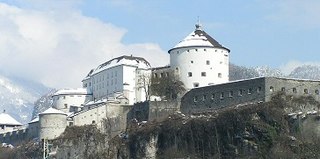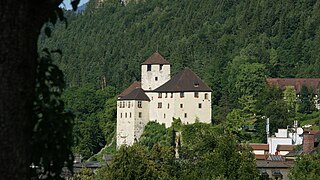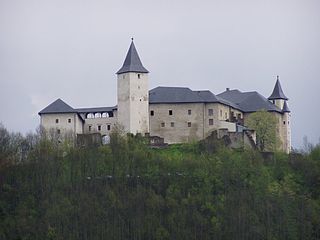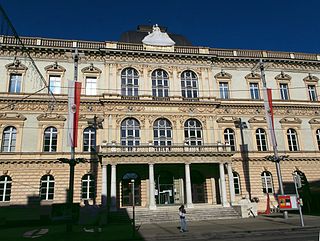 W
WThe Angelika Kauffmann Museum is a museum in Schwarzenberg, Vorarlberg (Austria) dedicated to the life and works of the Swiss painter Angelica Kauffman.
 W
WArtstetten Castle is a château near the Wachau valley in Lower Austria, in the community of Artstetten-Pöbring.
 W
WSommeregg is a medieval castle near Seeboden in the Austrian state of Carinthia, Austria. It is situated in the foothills of the Nock Mountains at an altitude of 749 m. The fortress served as an administrative seat in the Upper Carinthian estates held by the Counts of Ortenburg and Celje; it later was the residence of the Graben and Khevenhüller dynasties; ministeriales of the Austrian House of Habsburg.
 W
WEbensee was a subcamp of Mauthausen concentration camp established by the SS to build tunnels for armaments storage near the town of Ebensee, Austria, in 1943. The camp held a total of 27,278 male inmates from 1943 until 1945. Between 8,500 and 11,000 prisoners died in the camp, most from hunger or malnutrition. Political prisoners were most common, and prisoners came from many different countries. Conditions were poor, and along with the lack of food, exposure to cold weather and forced hard labor made survival difficult. American troops of the US 80th Infantry Division liberated the camp on May 6, 1945.
 W
WThe Egg Museum is a local history museum located in Egg in the Austrian state of Vorarlberg. It is the oldest regional museum in Vorarlberg. The museum was founded in 1904 and reopened again in 1988.
 W
WEhrenberg Castle is a castle located in Reutte in Tyrol, Austria.
 W
WThe Esperanto Museum and Collection of Planned Languages, commonly known as the Esperanto Museum, is a museum for Esperanto and other constructed languages in Vienna, Austria. It was founded in 1927 by Hofrat Hugo Steiner and was incorporated into the Austrian National Library as an independent collection in 1928. Today, it is a museum, library, documentation center, and archive. It accommodates the largest collection of constructed languages in the world and a linguistic research library for language planning. Its online catalogue is available online.
 W
WThe FLATZ Museum is a contemporary art museum in Dornbirn, Vorarlberg (Austria).
 W
WThe Bestattungsmuseum Wien is a museum in Vienna, Austria. With around 1000 exhibits, the Vienna Funeral Museum gives a comprehensive overview of funeral customs, burial rites, funerary art and the special Viennese perspective on death and provides information on the historical and current funeral services in Vienna.
 W
WHellbrunn Palace is an early Baroque villa of palatial size, near Morzg, a southern district of the city of Salzburg, Austria. It was built in 1613–19 by Markus Sittikus von Hohenems, Prince-Archbishop of Salzburg, and named for the "clear spring" that supplied it. Hellbrunn was only meant for use as a day residence in summer, as the Archbishop usually returned to Salzburg in the evening; therefore, there is no bedroom in Hellbrunn.
 W
WHittisau Women's Museum is a museum in Hittisau, Austria, devoted to women. It was founded in 2000 and is the only museum of its kind in the country.
 W
WThe Jewish Museum Hohenems is a regional museum in Hohenems in the Austrian state of Vorarlberg. The museum deals with the Jewish presence in Hohenems as well as surrounding regions. It also covers the Diaspora and Israel and puts the future of the European immigration society into focus.
 W
WThe Kufstein Fortress is the main landmark of Kufstein, a town in Tyrol, Austria. It is sometimes wrongly referred to as Geroldseck Fortress. It is on a hill commanding Kufstein proper. Kufstein Fortress is 507 metres (1,663 ft) above sea level.
 W
WThe Lower Austria Museum, formerly the Lower Austria State Museum, is the national museum for the state of Lower Austria and covers the fields of history, art and nature. It is located in St. Pölten in Lower Austria.
 W
WMauthausen was a Nazi concentration camp on a hill above the market town of Mauthausen, Upper Austria. It was the main camp of a group with nearly 100 further subcamps located throughout Austria and southern Germany. The three Gusen concentration camps in and around the village of St Georgen/Gusen, just a few kilometres from Mauthausen, held a significant proportion of prisoners within the camp complex, at times exceeding the number of prisoners at the Mauthausen main camp.
 W
WMillstatt Abbey is a former monastery in Millstatt, Austria. Established by Benedictine monks about 1070, it ranks among the most important Romanesque buildings in the state of Carinthia. The Benedictines were succeeded by the knightly Order of Saint George in 1469 and the Society of Jesus in 1598.
 W
WThe Museum of the Strauss Dynasty in Vienna is a museum dedicated to the Strauss family: Johann I, Johann II, Josef, Eduard and Johann III.
 W
WRiegersburg Castle is a medieval castle situated on a dormant volcano above the town of Riegersburg in the Austrian state of Styria. The castle is owned by the Princely Family of Liechtenstein and contains a museum with changing exhibitions. Riegersburg Castle is situated at a height of 450 m.(1476.38 feet)
 W
WSchattenburg is a castle, museum and restaurant in Feldkirch, Vorarlberg (Austria). Schattenburg is 480 metres (1,570 ft) above sea level..
 W
WSchloss Hartheim, also known as Hartheim Castle, is a castle at Alkoven in Upper Austria, some 14 kilometres (9 mi) from Linz, Austria. It was built by Jakob von Aspen in 1600, and it is a prominent Renaissance castle in the country. The building became notorious as one of the centers for the Nazi killing program known as Action T4, in which German citizens deemed mentally or physically unfit were systematically killed with poison gas. After 1942, these killings were extended to include Jews, Communists and others considered undesirable by the state. In this capacity it was known as the Hartheim Euthanasia Centre.
 W
WSchloss Stainz is a former monastery in Stainz, located in the Austrian state of Styria. Today, the Baroque complex belongs to the Counts of Meran and hosts two museum collections from the Universal Museum Joanneum.
 W
WSchloss Straßburg is a castle in Straßburg, Carinthia, Austria. Schloss Straßburg is 754 metres (2,474 ft) above sea level.
 W
WTrautenfels Castle is a palace located in the district of Liezen in Styria. It lies directly on the Enns at 673m in the municipality Pürgg-Trautenfels on a cliff protrusion at the foot of the Grimming.
 W
WThe Tyrolean State Museum, also known as the Ferdinandeum after Archduke Ferdinand, is located in Innsbruck, Austria. It was founded in 1823 by the Tyrolean State Museum Ferdinandeum Society.
 W
WThe Universalmuseum Joanneum is a multidisciplinary museum with buildings in several locations in the province of Styria, Austria. It has galleries and collections in many subject areas including archaeology, geology, paleontology, mineralogy, botany, zoology, history, art and folk culture. It is the oldest museum in Austria as well as the largest universal museum in central Europe with over 4.5 million objects in 13 departments and 12 locations in the Styrian cities of Graz, Stainz, Trautenfels, and Wagna. To reflect this status and its growth over the last two centuries, as well as to present a more recognizable image internationally, the Landesmuseum Joanneum was officially renamed to Universalmuseum Joanneum on 10 September 2009.
 W
WThe Vienna Museum is a group of museums in Vienna consisting of the museums of the history of the city. In addition to the main building in Karlsplatz and the Hermesvilla, the group includes numerous specialised museums, musicians' residences and archaeological excavations.